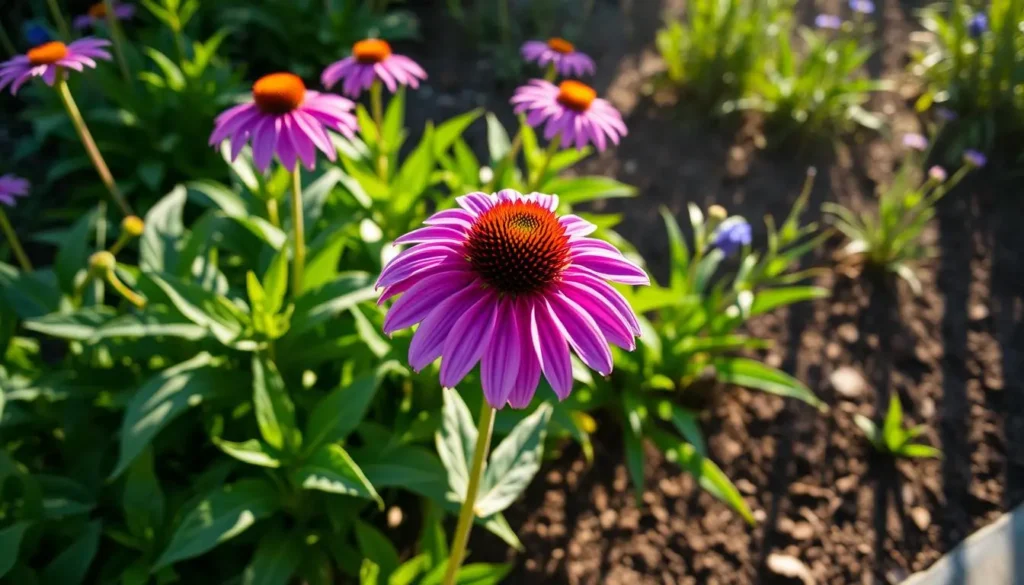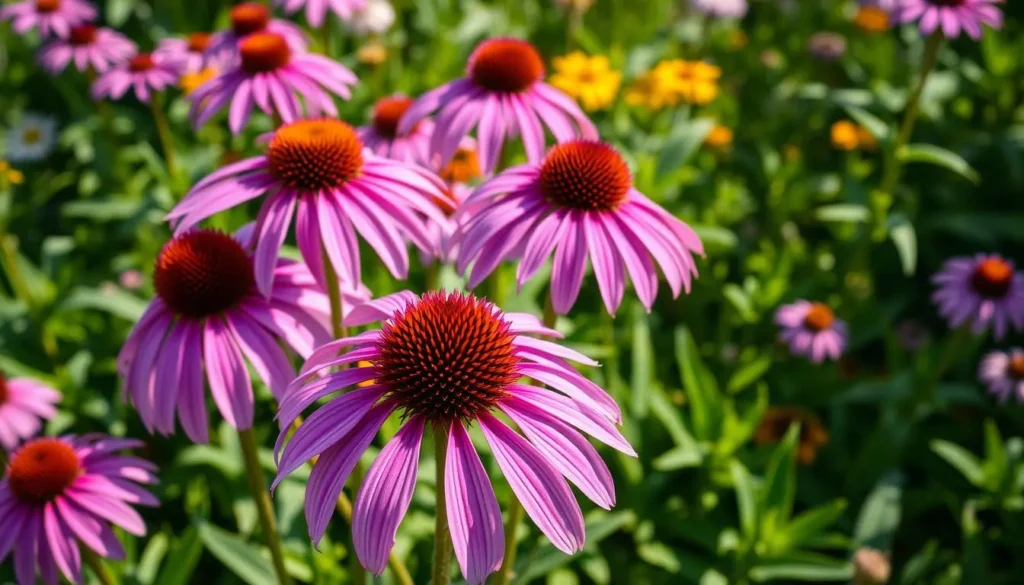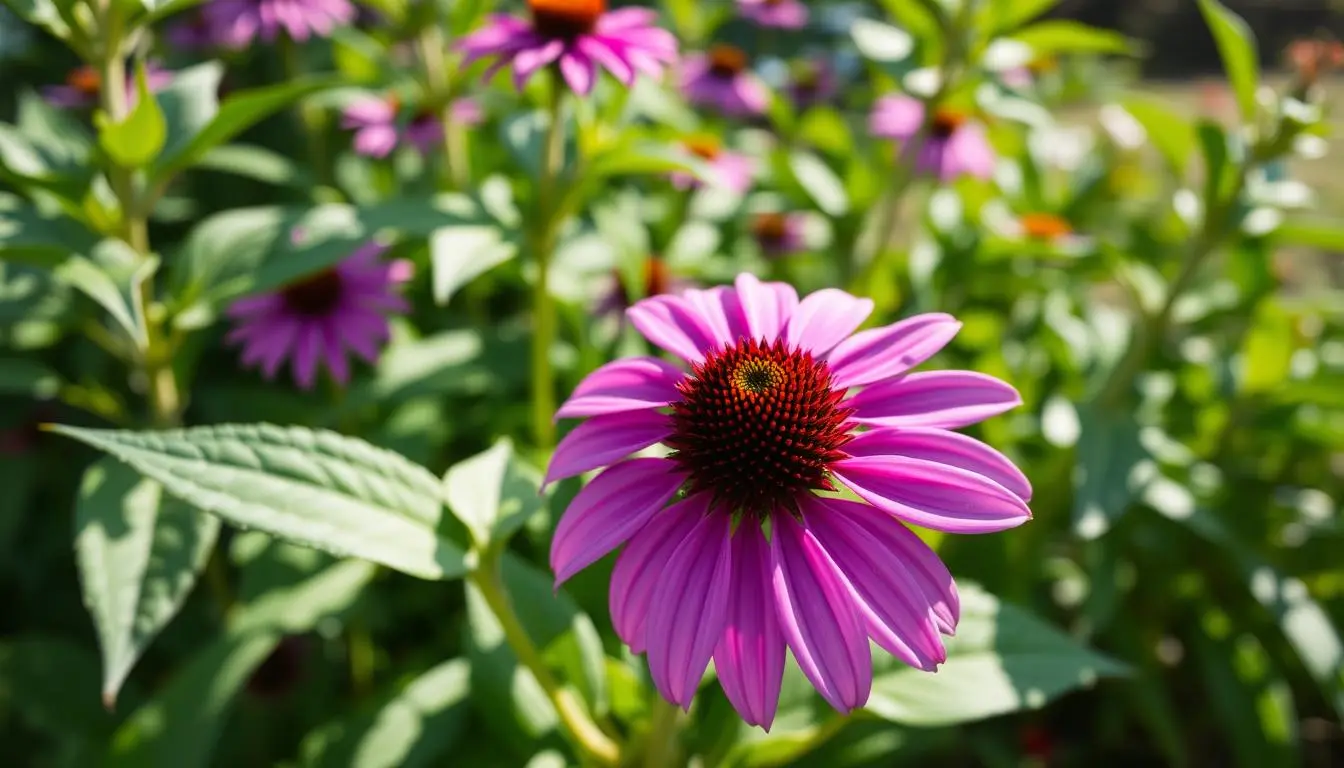When I walk into my garden, the bright purple of the Echinacea purpurea, or Purple Coneflower, catches my eye. This beautiful native perennial has been a favorite in my garden for years. It’s not just for its stunning flowers but also for its toughness and many uses. Let’s explore the fascinating world of this iconic American flower together. We’ll learn how to grow its timeless beauty in your garden.
Table of Contents
Understanding Purple Coneflower and Its Native Origins
The purple coneflower, known as Echinacea purpurea, is a treasure from North America. It comes from the continent’s natural habitats and diverse species. Learning about its heritage shows its cultural value and why it’s so popular.
Natural Habitat and Distribution
The purple coneflower grows mainly in the U.S.’s central and eastern parts, from Texas to Canada. It thrives in places like prairies, meadows, and open woodlands. It loves well-drained, dry to medium-moist soils, making it adaptable to various environments.
Species Varieties in North America
Besides Echinacea purpurea, there are other purple coneflower species in North America. The Echinacea pallida, or pale purple coneflower, has softer colors. The Echinacea angustifolia has narrower leaves. These species add to the purple coneflower’s rich heritage.
Historical Uses by Native Americans
Native American tribes have always valued the purple coneflower. They used its roots, leaves, and flowers for medicine. This included treating colds, boosting immunity, and aiding in wound healing. Today, people still study its health benefits.
“The purple coneflower is a true icon of North American native flora, offering not only visual delight but also a rich cultural heritage that has endured for centuries.”
Essential Growing Requirements for Purple Coneflower
To make your purple coneflower plant grow well, knowing its needs is key. This beautiful native plant does best in certain soil, sunlight, and temperature.
Optimal Soil Conditions
The purple coneflower likes soil that drains well and is slightly acidic. The pH should be between 6.0 and 7.0. Good drainage prevents root rot and keeps the plant healthy.
Sunlight Needs
This plant loves the sun and needs at least 6 to 8 hours of direct sunlight daily. Less sun can make it grow weak and reduce blooms.
Temperature Preferences
This hardy perennial grows well in USDA Hardiness Zones 3 to 9. It can handle cold winters and hot summers, making it versatile for many places.
“The purple coneflower is a resilient and adaptable plant that can thrive in various growing conditions, as long as its essential requirements are met.”
By knowing and meeting the purple coneflower’s needs, you can help it grow its best. It will bloom beautifully and reach its full coneflower height, enhancing your garden’s beauty.
How to Start Purple Coneflower from Seeds
Want to add purple coneflowers to your garden? You can start them from seeds easily. This guide will help you grow purple cone flowers indoors or directly in the garden.
Indoor Seed Starting Methods
Start purple coneflower seeds indoors for an early bloom. Use seed trays or pots with a good seed starting mix. Keep the soil moist and place them in a sunny spot with morning sun and afternoon shade. Seeds usually germinate in 2-3 weeks.
Direct Sowing Guidelines
Or, sow purple coneflower seeds directly in your garden. Pick a spot with partial sun. Loosen the soil and mix in compost. Scatter the seeds and cover them lightly with soil. Keep the soil moist until germination, which takes 2-3 weeks.
Transplanting Best Practices
Transplant seedlings whether they were indoors or directly sown. Carefully move the young plants to their new home, spacing them 18-24 inches apart. Water them well and keep the soil moist until they settle.
By following these steps, you can grow purple coneflowers from seed and enjoy their beauty for years.
Ideal Soil Conditions and Sun Requirements
To grow healthy echinacea purple coneflower or purple coneflower echinacea, you need the right soil and sunlight. Make sure your purple coneflower gets the best growing conditions.
The echinacea purple coneflower likes soil that drains well and is slightly acidic. It should have a pH between 6.0 and 7.0. Adding compost or aged manure to your soil helps it retain moisture and nutrients. This makes your purple coneflower echinacea grow better.
Purple coneflower echinacea needs full sun to grow well. It should get at least 6 hours of direct sunlight each day. More sunlight, 8 to 10 hours, is even better. While it can handle some shade, less sun means fewer flowers and weaker plants.

“Purple coneflower is a resilient and adaptable native plant that can thrive in a variety of soil conditions, as long as it receives ample sunlight.”
With the right soil and sunlight, your echinacea purple coneflower will bloom beautifully. These flowers will brighten your garden and attract pollinators.
Watering and Maintenance Tips
Caring for your purple coneflower (Echinacea purpurea) is easy. It needs a few key practices for growth and health. As a hardy perennial, it’s drought-tolerant but still needs regular watering.
Drought Tolerance Features
The purple coneflower is tough and can handle dry spells. Its deep roots help it find water deep in the soil. But, it still needs water during long dry times to stay healthy and blooming.
Seasonal Watering Schedule
- In spring and early summer, water the purple coneflower plants about 1 inch per week. This helps with foliage and flower growth.
- When it’s hot and dry in summer, water every 2-3 weeks. Let the soil dry a bit between waterings.
- In fall, water less, about once a month. This helps the plant get ready for winter without too much water.
Mulching Requirements
Use 2-3 inches of organic mulch around the purple coneflower plants. It keeps the soil moist, stops weeds, and protects roots in cold weather. Shredded bark, wood chips, or leaf litter are great for mulching.
“The purple coneflower is a true garden workhorse, thriving on minimal care and providing a stunning display of color throughout the growing season.”
Common Pests and Diseases of Echinacea Purpurea
Keeping your purple coneflowers echinacea healthy means watching out for pests and diseases. Knowing what to look for helps you protect your echinacea purpurea purple coneflower plants.
The leaf-cutter bee is a big worry for purple coneflowers echinacea. These bees make unique patterns on leaves as they build their nests. Though it looks bad, it’s not usually harmful to the plant.
Aphids are another pest. They live in groups and suck the sap from echinacea purpurea purple coneflower plants. This can slow growth and turn leaves yellow or wilted. Check your plants often and use water or ladybugs to fight aphids.
- Leaf-cutter bees can create distinctive, scalloped patterns on leaves
- Aphids can gather in colonies and feed on sap, causing stunted growth and yellowing leaves
- Powdery mildew can appear as a white, powdery coating on leaves, reducing photosynthesis
- Bacterial wilt can cause sudden wilting and collapse of the plant
Fungal diseases like powdery mildew can harm purple coneflowers echinacea. It looks like a white, powdery coating on leaves. This can hurt photosynthesis and plant health. Good air flow and avoiding overhead watering can stop powdery mildew.
Bacterial wilt is another problem. It makes echinacea purpurea purple coneflower plants wilt and collapse. This disease is hard to treat. So, it’s key to keep your garden clean and remove sick plants quickly.

By knowing about and dealing with these pests and diseases, you can keep your purple coneflowers echinacea healthy. They’ll keep growing strong in your garden.
Companion Planting with Purple Coneflower
Adding purple coneflower (Echinacea purpurea) to your garden opens up endless possibilities. This native perennial is not just beautiful. It also attracts pollinators, making it a great choice for any garden.
Best Plant Combinations
Purple coneflower looks great with many native plants. Try pairing it with black-eyed Susan (Rudbeckia hirta), butterfly bush (Buddleja davidii), and purple prairie clover (Dalea purpurea). These combinations make your garden vibrant and attractive.
Garden Design Suggestions
- Plant purple coneflower in clusters or drifts for a bold look.
- Put it in perennial borders with ornamental grasses for color and texture.
- For a softer look, use the pale purple coneflower (Echinacea pallida).
Creating Pollinator Gardens
Purple coneflower is a top choice for attracting pollinators. Its nectar-rich flowers draw in bees, butterflies, and hummingbirds. Adding this plant to your garden makes it a haven for pollinators.
To succeed with purple coneflower, let its beauty shine. Pair it with plants that do well in similar conditions. With some planning, you can create a stunning garden that celebrates native beauty.
Harvesting and Using Purple Coneflower
The purple coneflower echinacea, also known as echinacea purpurea, is a plant with many uses. It’s beautiful to look at and good for health. Learn how to use this native American plant.
Harvesting the Flowers
The purple coneflower echinacea flowers are perfect for bouquets or dried arrangements. Cut the flowers when they’re fully open. Leave a few inches of stem on each flower.
Hang the flowers upside down in a cool, dry spot. This helps keep their color and shape.
Medicinal Uses
The roots, leaves, and flowers of echinacea purpurea are good for health. Take the roots in the fall when the plant is dormant. Harvest the leaves and flowers during the growing season.
Dry the plant in a cool, shaded area. Then, store it in airtight containers. Use it in teas, tinctures, and supplements.
“The purple coneflower echinacea has been used for centuries by Native Americans. It helps boost the immune system and reduce inflammation.”
Preserving the Harvest
- Dry the plant material in a cool, dark place with good air circulation.
- Store dried echinacea purpurea in airtight containers, away from direct light and moisture.
- Properly stored, the medicinal properties of purple coneflower echinacea can be maintained for up to two years.
Learning to harvest and preserve echinacea purpurea lets you enjoy its beauty and health benefits all year.
Winter Care and Seasonal Maintenance
As the vibrant purple coneflowers (Echinacea purpurea) start to fade in the fall, it’s time to get your garden ready for winter. Taking care of your purple coneflowers and other perennials during the cold months is key. This way, they can thrive for years to come.
Fall Cleanup Guidelines
When autumn comes, follow these steps for your purple coneflowers:
- Cut back the dead or dying foliage and stems, leaving a few inches of the plant above the soil.
- Remove any fallen leaves or debris around the base of the plants to prevent disease and pest issues.
- Apply a 2-3 inch layer of mulch around the base of the plants, taking care not to cover the crowns.
- Consider dividing overcrowded purple coneflower clumps to encourage better growth in the following season.
Spring Revival Techniques
When spring comes, it’s time to wake up your purple coneflowers and other perennials:
- Gently remove any remaining mulch or debris from around the base of the plants.
- Check for new growth and remove any dead or damaged foliage.
- Apply a balanced, slow-release fertilizer to provide essential nutrients for healthy growth.
- Consider staking or caging your purple coneflowers to support the tall, sturdy stems as they emerge.
By following these seasonal maintenance tips, you can ensure your purple coneflowers and other perennials thrive. They will bring their natural beauty to your garden year after year.
Conclusion
As you’ve learned, the purple coneflower (Echinacea purpurea) is a standout native perennial. It’s perfect for your garden. This plant not only looks great with its bright flowers but also helps pollinators and the environment.
This guide has given you all you need to know about growing purple coneflower. It’s great for both experienced gardeners and newcomers. You’ll learn how to grow this beautiful Echinacea purpurea and enjoy its many benefits.
We hope you’ll explore purple coneflower’s many uses in your garden. By adding it, you’ll make your garden beautiful and help protect native ecosystems. Start growing this amazing Echinacea purpurea and let its beauty inspire you to love nature more.

